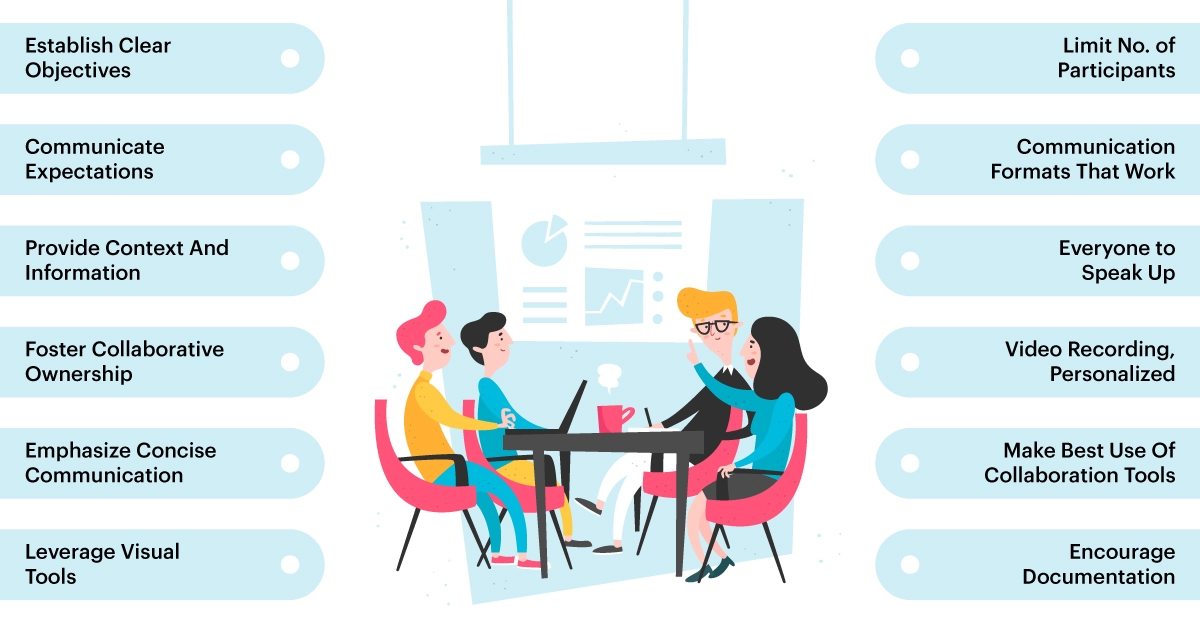When the working world is feverishly sounding off jargon like remote-first, hybrid work, and virtual teams, it's certainly not without reason. As corporations inch towards hybrid and remote work, technologies that enable communication, concentration, and collaboration are imperative to have. Video meetings have boomed in deployment in the last few years, keeping remote teams connected and engaged.
But when these teams are spread across geographies and multiple time zones, getting the members together on a call can be quite chaotic. Members missing from video meetings, slow internet speeds, overlapping conversations, and lack of productivity are issues that remote teams face with such meetings.
The Need to Replace Synchronous Meetings
Did you know that the average employee spends 4 hours every week in meetings? This is a lot of time for professionals, considering that most of these hours are spent unproductively. To top this off, when live or "synchronous" meetings are scheduled for remote teams across geographies and different functions, it could lead to wasted time.
Whether it's a small team within a large organization or the entire company strength in a start-up, live remote meetings contribute very little towards improving the workflow of employees. Not to take credit away from the benefits of on-site meetings, but there is an inherent lack of flexibility in such meetings for hybrid and remote-first teams.
Synchronous meetings are required for brainstorming ideas, solving critical problems, and planning budgets for the financial year. And the time has come for remote and hybrid teams to consider swapping the traditional sync with asynchronous meetings for any requirement.
Asynchronous Meetings – A Quick Overview
Meetings that don't take place in real-time are basically called async meetings. Participants can communicate and collaborate with other team members at their own pace, based on their own schedules, and in their own time zones. Asynchronous meetings are usually conducted through pre-recorded written or video communication like email, instant, and video messaging.
Harvard Business Review surveyed 182 senior managers from a mixture of industries and found 65% of them claimed that meetings kept them from completing their work. A further 71% of this lot said that meetings were unproductive and inefficient. This just goes to show how pressing the need for asynchronous meetings has become.
The overarching objective of async meetings is to allow participants to work collaboratively and effectively, without needing everyone to be available at the same time. For remote and hybrid teams, this is a huge boon! It purges the problem of scheduling conflicts and permits individuals to work at their own pace, schedule, and convenience.
Popular American web software company Basecamp believes deeply in remote meetings. Founder Jason Fried has been vocal about his belief that face-to-face meetings are "notorious timewasters." Basecamp emphasizes the significance of clear and concise written communication as a crucial skill for remote teams. They advocate for asynchronous communication as the default, relying on detailed writing rather than meetings or chats. In addition, they utilize automatic check-ins and scheduled questions to encourage regular sharing and communication among team members.
How Async Meetings are Conducted in 2023
1. Multimedia Presentations
Asynchronous meetings see the use of multimedia elements such as pre-recorded videos, voice recordings, and interactive presentations to enhance engagement and convey information effectively.
2. AI-powered Collaboration
Artificial intelligence (AI) features are being integrated into collaboration platforms, enabling automated organization, categorization, and summarization of meeting discussions and documents, making it easier to navigate and extract key insights.
3. Timeboxing and Deadlines
To maintain productivity and ensure timely progress, timeboxing techniques are being applied to allocate specific time slots for each agenda item or discussion point. Deadlines for contributions and feedback are clearly communicated to maintain momentum and meet project timelines.
4. Virtual Brainstorming Sessions
Asynchronous meetings leverage virtual brainstorming techniques, such as using collaborative idea boards or asynchronous brainstorming tools, allowing participants to contribute ideas and insights at their own pace.
5. Gamification of Collaboration
Some asynchronous meetings see the use of gamification elements to promote engagement and motivation. This may include challenges, badges, or rewards for active participation, fostering a sense of fun and accomplishment among participants.
6. Structured Decision-making Processes
Meeting organizers sometimes implement structured decision-making frameworks, such as the DACI (Driver, Approver, Contributor, Informed) model, to clearly define roles and decision-making authority within the asynchronous context, ensuring clarity and accountability.
Top 3 Advantages of Asynchronous Meetings
1. Ease of Doing Business for Remote Teams
For remote teams that are dispersed across multiple cities, countries, and time zones, async meetings are a blessing. Gathering participants for real-time meetings can be tricky, time-consuming, and expensive in the end. Async meetings can be flexibly scheduled to enable team members to contribute better and clearer.
Zapier is a classic example of a SaaS company that has its employees scattered across 27 different countries. Zapier faced challenges with conducting efficient stand-up meetings for his geographically dispersed team. Using an asynchronous meeting tool, combined with Slack's threaded response feature, they were able to overcome time zone barriers and make stand-ups minimally disruptive. This shift to asynchronous stand-ups improved productivity and work-life balance for the remote team at Zapier.
2. Rich Conversations, Richer Ideation
The time constraint of traditional meetings is a real gripe. Not only do async meetings allow for better voicing of individual opinions, but they also encourage participants to ideate in their own time and come up with better responses during meetings.
These meetings stimulate deep thinking, as there is very little interruption while doing research, coding, or developing a product strategy. Video responses are becoming more common nowadays for async meetings, owing to reduced time pressure.
3. Combating Meeting Fatigue
IT and product development teams normally have back-to-back meetings throughout the day. The downside of such constant meetings is "Meeting Fatigue" – the feeling of physical and mental exhaustion after multiple video conferencing calls. The GoFloaters report indicates that to have the flexibility of work-life balance, many teams chose to have meetings on Saturdays as well.
Best Practices of Async Meetings
Whatever your current situation – hybrid employee, remote manager, or someone who wants to make the best out of hybrid/remote working, the below best practices of async meetings can give you a better bang for your buck:
- Establish Clear Objectives: Clearly define the purpose and objectives of the meeting leaving no room for ambiguity. Provide participants with a clear understanding of what needs to be accomplished asynchronously.
- Communicate Expectations: Communicate the timeline, deadlines, and expected contributions from participants. Ensure everyone understands their roles and responsibilities in the asynchronous meeting process.
- Provide Context And Information: Share relevant background information, documents, and resources to provide participants with the necessary context for their contributions. This helps ensure that everyone has the information they need to make informed decisions.
- Foster Collaborative Ownership: Encourage participants to take ownership of their contributions and actively engage in collaborative problem-solving, promoting a sense of shared responsibility and accountability.
- Emphasize Concise Communication: Cultivate a culture of concise and effective communication, encouraging participants to convey their thoughts and ideas succinctly while maintaining clarity and precision.
- Leverage Visual Tools: Capitalize on visual collaboration tools such as MURAL to facilitate clear and engaging visualizations, enhancing comprehension and fostering creative thinking among participants. MURAL enhances asynchronous meetings by providing a visual and interactive platform for collaboration. It enables participants to:
- visualize and organize ideas on a digital canvas - facilitating effective communication and understanding
- The platform also serves as a documentation tool, capturing discussions, decisions, and action items for easy reference.
- MURAL enables remote collaboration to become seamless, allowing team members to contribute at their convenience from different time zones.
- The visual tools and templates offered by MURAL support visual thinking and problem-solving, promoting creativity and innovation in asynchronous meetings.
- Can be easily integrated with other collaboration tools which further streamlines workflows, ensuring a smooth and inclusive collaboration experience for all participants.
- Limit No. of Participants : Working in smaller teams works better for async meetings. It promotes better communication and drops the amount of information to be shared, processed, and accepted by each person in the meeting.
- Communication Formats That Work : The coolest part of async meeting communication for hybrid teams is that you can try out different formats to suit the team's liking and acceptance. For instance, a long email thread or a collaborative Google doc would work for discussions, while quick updates can be done through instant messaging. Meetings that require high-level, meaningful messages can be video/audio messages to the intended participants.
- Everyone to Speak Up : Asynchronous meetings organically promote each member of hybrid teams to speak up, which not only opens communication channels for introverts but also builds excellent relationships with cross-functional teams.
- Video Recording, Personalized : Async meetings take video recording a notch up by personalizing video meetings and video responses to team colleagues.
- Make Best Use Of Collaboration Tools: Utilize collaboration tools like project management platforms, shared documents, or chat platforms to facilitate asynchronous discussions. These tools enable participants to contribute at their convenience, track progress, and access information easily.
- Encourage Documentation: Emphasize the importance of documenting decisions, meeting summaries, and action items. This ensures that information is accessible to everyone, even those who couldn't attend the meeting, and serves as a reference for future discussions.
Wrapping Up
Stand-up meetings are still a magnificent way to hear everyone out on the team, about any recent company updates, and pitch short ideas if time permits. Irrespective of whether you adopt sync or async meetings, these stand-up calls are mandatory, especially for growing start-ups. Coworking meeting spaces for hybrid teams are extensively useful for such meetings.
Except for these stand-ups, synchronous meetings must only involve people who can contribute towards a clear business outcome or finalizing a decision. Otherwise, the future of remote and hybrid work is looking bright in the direction of asynchronous meetings.
There are very few platforms that provide organizations with the opportunity to book coworking spaces without administrative overheads. GoFloaters Worqflexi platform features an incredible inventory of work and meetings spaces across 40-plus countries and 300-plus coworking space brands.
For a detailed lowdown of how India embraced hybrid work, head over to GoFloaters to download the report.


